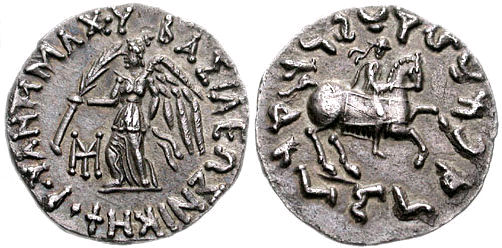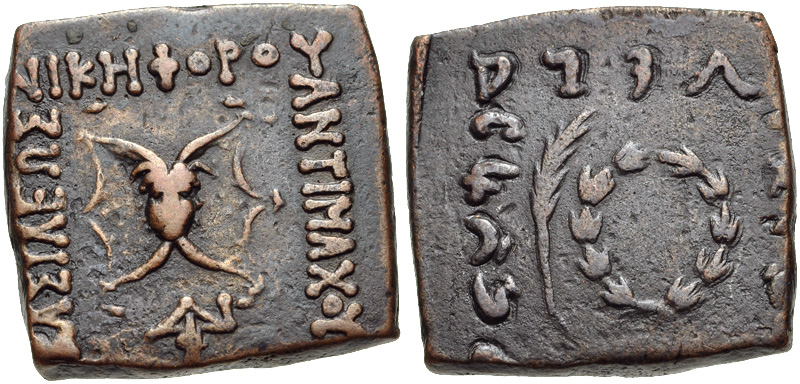Antimachus II on:
[Wikipedia]
[Google]
[Amazon]
 Antimachus II Nikephoros (
Antimachus II Nikephoros (
 Antimachus II did not strike a portrait on his coins, likely since this was not custom in India. Neither did the early kings strike tetradrachms. Antimachus II struck a large number of bilingual drachms on the same lighter Indian standard as Apollodotus I, though round in shape. On the obverse is
Antimachus II did not strike a portrait on his coins, likely since this was not custom in India. Neither did the early kings strike tetradrachms. Antimachus II struck a large number of bilingual drachms on the same lighter Indian standard as Apollodotus I, though round in shape. On the obverse is
 Antimachus II Nikephoros (
Antimachus II Nikephoros (Greek
Greek may refer to:
Greece
Anything of, from, or related to Greece, a country in Southern Europe:
*Greeks, an ethnic group.
*Greek language, a branch of the Indo-European language family.
**Proto-Greek language, the assumed last common ancestor ...
: ; the epithet means "the Victorious") was an Indo-Greek
The Indo-Greek Kingdom, or Graeco-Indian Kingdom, also known historically as the Yavana Kingdom (Yavanarajya), was a Hellenistic-era Greek kingdom covering various parts of Afghanistan and the northwestern regions of the Indian subcontinent ( ...
king. He ruled a vast territory from the Hindu-Kush to the Punjab
Punjab (; Punjabi: پنجاب ; ਪੰਜਾਬ ; ; also romanised as ''Panjāb'' or ''Panj-Āb'') is a geopolitical, cultural, and historical region in South Asia, specifically in the northern part of the Indian subcontinent, comprising a ...
around 170 BCE. He was almost certainly the eponymous son of Antimachus I
Anthimachus I Theos (Greek: ; known as Antimakha in Indian sources) was believed to have been an illegitimate son of Euthydemus, and one of the Greco-Bactrian kings, generally dated from around 185 BC to 170 BC.
Rule
William Woodthorpe Tarn ...
, who is known from a unique preserved tax receipt. Bopearachchi dated Antimachus II to 160–155 BCE on numismatical grounds, but changed this to 174–165 BCE after the tax receipt was revealed to synchronise his reign with that of Antimachus I.Boperarachchi (1991) and (1998), respectively. R. C. Senior has not dated Antimachus II but thinks that his coins were possibly Indian issues of Antimachus I
Anthimachus I Theos (Greek: ; known as Antimakha in Indian sources) was believed to have been an illegitimate son of Euthydemus, and one of the Greco-Bactrian kings, generally dated from around 185 BC to 170 BC.
Rule
William Woodthorpe Tarn ...
, despite their different epithets and coin types.
In both of Boperachchi's reconstructions, Antimachus II was succeeded by Menander I
Menander I Soter ( grc, Μένανδρος Σωτήρ, Ménandros Sōtḗr, Menander the Saviour; pi, मिलिन्दो, Milinda), was a Greco-Bactrian and later Indo-Greek King (reigned c.165/155Bopearachchi (1998) and (1991), respectivel ...
who inherited three of his four monograms. Antimachus II probably fought against the Bactrian king Eucratides I
Eucratides I the Great ( Koinē Greek: , ''Eúkratides Mégas'') (reigned 172/171–145 BC) was one of the most important Greco-Bactrian kings. Eucratides overthrew the Euthydemid dynasty and restored the Diodotids to power. He fought agains ...
, who had dethroned his father in Bactria.
Coins of Antimachus II
 Antimachus II did not strike a portrait on his coins, likely since this was not custom in India. Neither did the early kings strike tetradrachms. Antimachus II struck a large number of bilingual drachms on the same lighter Indian standard as Apollodotus I, though round in shape. On the obverse is
Antimachus II did not strike a portrait on his coins, likely since this was not custom in India. Neither did the early kings strike tetradrachms. Antimachus II struck a large number of bilingual drachms on the same lighter Indian standard as Apollodotus I, though round in shape. On the obverse is Nike
Nike often refers to:
* Nike (mythology), a Greek goddess who personifies victory
* Nike, Inc., a major American producer of athletic shoes, apparel, and sports equipment
Nike may also refer to:
People
* Nike (name), a surname and feminine give ...
, and on the reverse a king on horseback.
He also issued bilingual bronzes with aegis
The aegis ( ; grc, αἰγίς ''aigís''), as stated in the ''Iliad'', is a device carried by Athena and Zeus, variously interpreted as an animal skin or a shield and sometimes featuring the head of a Gorgon. There may be a connection with a d ...
/ laurel wreath
A laurel wreath is a round wreath made of connected branches and leaves of the bay laurel (), an aromatic broadleaf evergreen, or later from spineless butcher's broom (''Ruscus hypoglossum'') or cherry laurel (''Prunus laurocerasus''). It is a s ...
and palm. Both these and the goddess Nike seem to allude to his epithet ''"the Victorious".''
See also
*Greco-Buddhism
Greco-Buddhism, or Graeco-Buddhism, is the cultural syncretism between Hellenistic culture and Buddhism, which developed between the fourth century BC and the fifth century AD in Gandhara, in present-day north-western Pakistan and parts of nort ...
*Indo-Scythians
Indo-Scythians (also called Indo-Sakas) were a group of nomadic Iranian peoples of Scythian origin who migrated from Central Asia southward into modern day Pakistan and Northwestern India from the middle of the 2nd century BCE to the 4th centu ...
Notes
Sources
* * *"Sylloge Nummorum Graecorum 9", American Numismatic Society, New York, 1997. {{DEFAULTSORT:Antimachus 02 Greco-Bactrian kings 2nd-century BC rulers in Asia Euthydemid dynasty